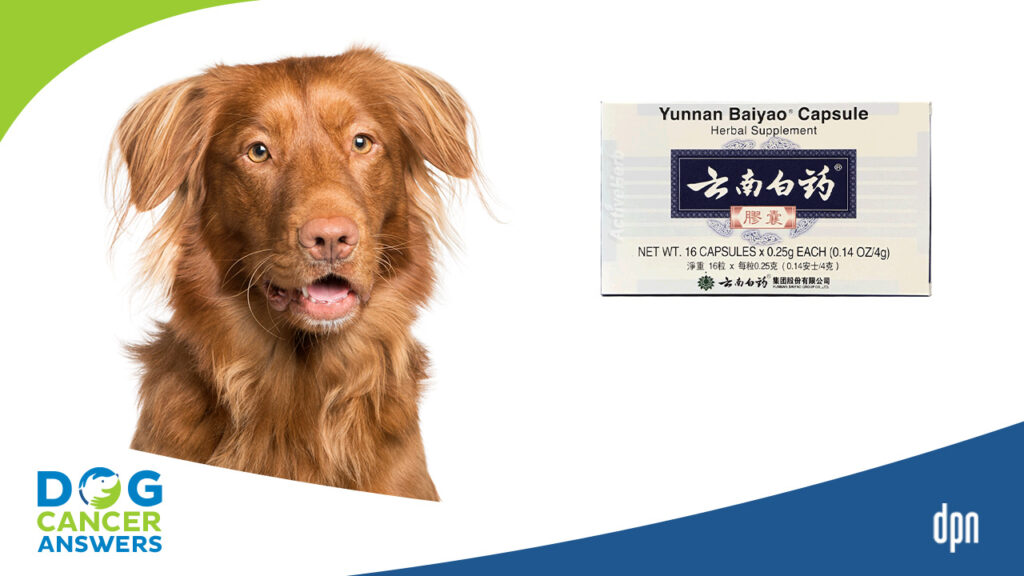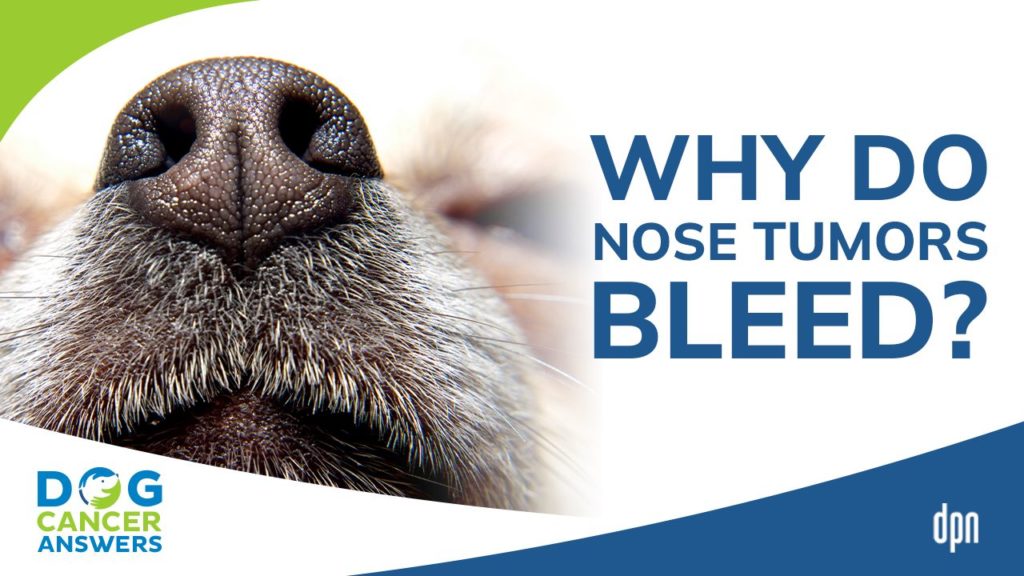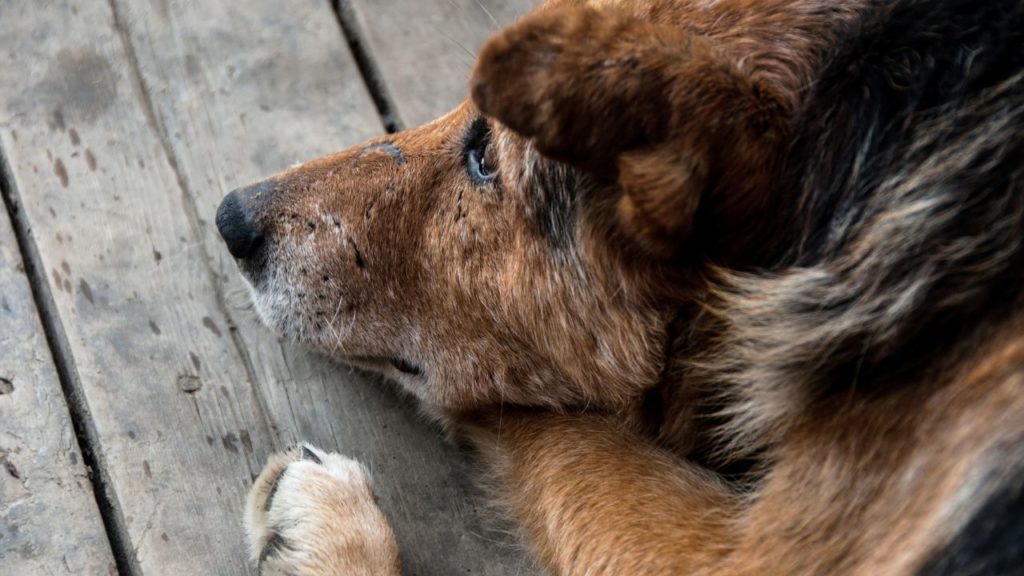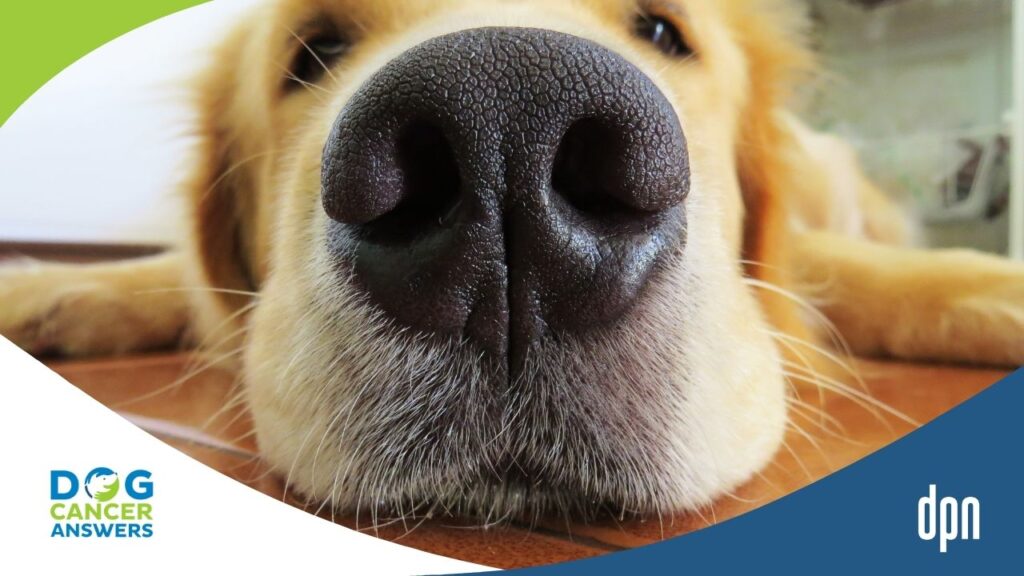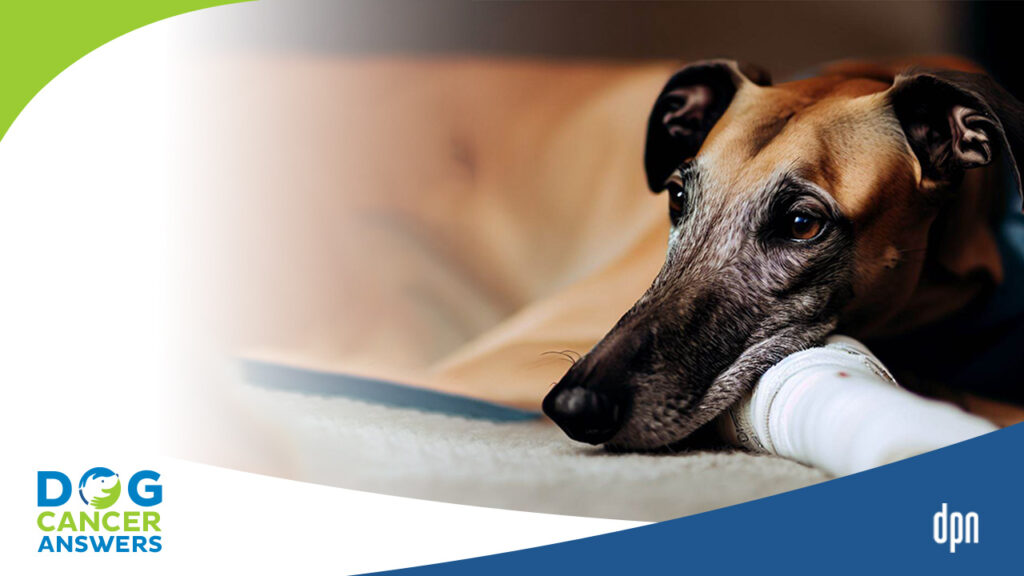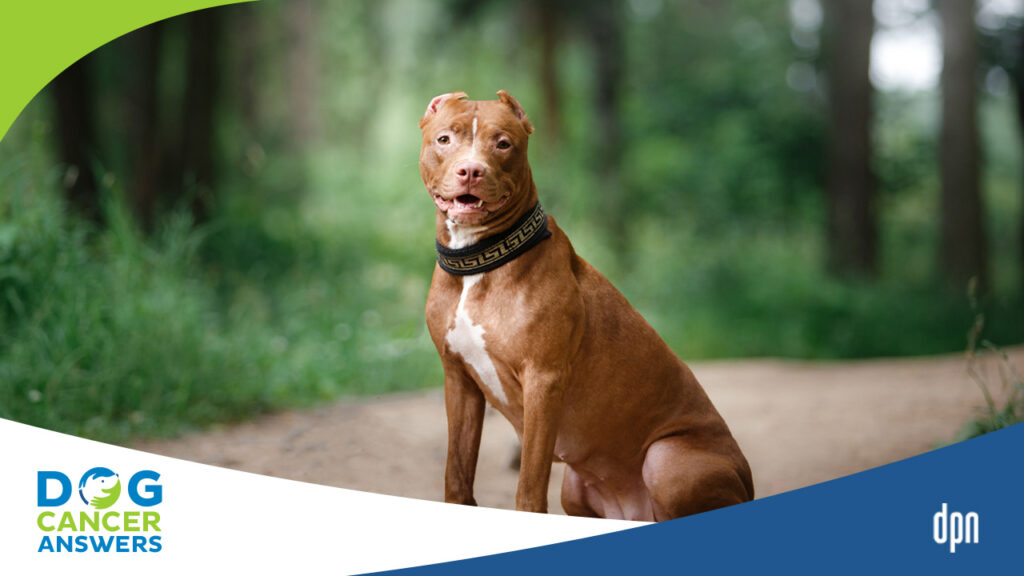[00:00:00] >> James Jacobson: Today’s show is brought to you by the bestselling book The Dog Cancer Survival Guide: Full Spectrum Treatments to Optimize Your Dog’s Life Quality and Longevity. It’s available everywhere books are sold in both paperback and digital editions and on the publisher’s website at DogCancerBook.com. Use coupon code PODCAST on that website to get 10% off the Dog Cancer Survival Guide today.
[00:00:29] >> Nancy Reese: So you don’t want to put so much pressure that the tissue around it starts turning white, because that means you’re compressing off all circulation. That’s the same principle that applies to tourniquets. Tourniquets can be lifesaving, but they cause significant damage because they truly cut off all the circulation to an area.
So if you push so much pressure that you’re starting to see the area around that kind of turn white, you’re probably applying too much.
[00:00:56] >> Announcer: Welcome to Dog Cancer Answers, where we help you help your dog with cancer. Here’s your host, James Jacobson.
[00:01:04] >> James Jacobson: Hello friend, and welcome to Dog Cancer Answers. Today we’re going to tackle a topic that is beneficial, not only to owners of dogs with certain types of cancer, but also to dog owners in general. As perfect as our pooches may be, every once in a while, you know, they get themselves into a little bit of trouble. And some of that trouble might lead to a bleeding wound. To discuss how to stop bleeding in your dog, we’re joined once again by our chief veterinary editor, Dr. Nancy Reese, an experienced veterinarian who has a Master’s in Preventative Veterinary Medicine and a PhD in Epidemiology.
Dr. Nancy, thank you so much for being with us today.
[00:01:51] >> Nancy Reese: Well, thank you for having me. It’s always a pleasure to talk to you guys.
[00:01:54] >> James Jacobson: Today we’re going to talk about a bloody topic, and that is, uh, you know, things that can happen related to blood. I hate blood Nancy. Things that can happen, uh, when your dog has had some sort of trauma.
So when is bleeding considered an emergency?
[00:02:12] >> Nancy Reese: So probably the most common source we have about phone calls for bleeding is when people clip a toenail too close. So it always looks like a lot of bleeding, but that’s not something where they’re actually going to lose a significant amount of blood. But for something like that, if you know you’re going to trim your dog’s nails, having something like some styptic powder, which is stuff you can buy at pet food or pet stores, that works great for, you know, clotting that blood on a bloody toenail. But I’ve had people use cornstarch or flour as an emergency backup because it just provides kind of a substance for the blood cells to grab onto and, and clot the blood. So bloody toenails are a very frequent source of bleeding, but obviously you can have all sorts of other things, you know, sharp objects in the house, or anything out in the yard that can certainly cause more significant bleeding.
[00:03:08] >> James Jacobson: Okay. And so, you know, styptic powder, pretty simple thing, but let’s turn this to a more aggressive, or scary type of bleeding with it could be connected to cancers. Cause there are some cancers that are likely to cause bleeding right?
[00:03:23] >> Nancy Reese: Right. Absolutely, and the, kind of the classic one that we think of is something like a hemangiosarcoma. So that can cause more often internal bleeding, which is a little harder to be able to do something about or recognize at home. Although Yunnan baiyao is, and I think that’s been talked about on this show in several different contexts and episodes.
[00:03:44] >> James Jacobson: And we’ll put links to Yunnan baiyao conversations in today’s show notes that, so that people can learn more about that.
[00:03:50] >> Nancy Reese: Perfect. That’s great because the capsules themselves seem to have some anti bleeding properties, and then the packages usually come with a, sort of a little mysterious emergency red pill –
[00:04:01] >> James Jacobson: The red pill.
[00:04:02] >> Nancy Reese: -and in case – the red pill! – and in cases of, you know, that uncontrolled bleeding, people will use that, that red pill. But you can even get some of the hemangiosarcomas can be on the skin and rupture open, or other types of tumors that might accidentally get hit and bleed, and you can use Yunnan baiyao topically as well, and that can help. Or with a bloody nose, you can even try some topically there. You don’t want to be squirting it far up the nose, but if it’s an, kind of an external bleed, you can open those Yunnan baiyao capsules and put some of the powder directly on something bleeding, and that, that can help stop things until you can get to an emergency vet clinic.
[00:04:43] >> James Jacobson: Okay. So is it mainly hemangiosarcoma and nasal tumors that cause bleeding issues?
[00:04:50] >> Nancy Reese: Nasal tumors is a huge one because they often will sneeze a lot with those and the nasal passages, kind of like ears, they are very well vascularized, or have a lot of blood vessels.
So when something starts to bleed, it bleeds a lot now. And so ears and noses, there are places that are always difficult to stop bleeding from. Paw pads is another one.
[00:05:13] >> James Jacobson: So just to, you know, a naive question, but one that is in my head because I am naive, what is the difference or similarity between dog’s blood and human blood?
[00:05:24] >> Nancy Reese: Well, they’re, they’re really quite similar in terms of most animals have red blood cells that look fairly similar, they have platelets, which are responsible for clotting, and then they have different types of white and red blood cells. And then the liquid part of the blood, the serum and plasma, which has clotting factors.
So there’s actually a lot of similarities between human and dog blood. The numbers are usually a little bit different as to the percentages of cells or absolute counts, but otherwise they’re reasonably similar.
[00:05:54] >> James Jacobson: And do they have blood typing, you know like O, A, B, uh as well?
[00:05:58] >> Nancy Reese: They do. It’s not the same blood types that we have in terms of the ABO pattern, but there are definitely blood types.
And before giving transfusions to an animal, it is ideal to blood type them. Because if you give the wrong blood – usually the first time you can get by with, uh, any similar species blood, but if you have to do multiple transfusions, they should be typed to minimize any kind of transfusion reaction.
[00:06:23] >> James Jacobson: Let’s take a break right here. We will be back in a quick moment.
Welcome back. We are speaking with Dr. Nancy Reese about bleeding in your dog. So I’ve held some Greyhounds in my experience who had hemangiosarcoma, and they were just sort of like bleeding out, it was sort of leaching through the skin. And it was really a difficult thing because the dog wasn’t all that aware of what was happening, but it was very apparent. In situations where you have that, what do you do?
[00:07:00] >> Nancy Reese: So some of the things, the general bleeding first aid procedures can help a little bit. So applying direct pressure, if it’s actually bleeding out through the skin where you’re seeing the liquid pooling there, you can apply some gentle, direct pressure. You don’t want to put so much pressure that you would cause more damage, but if you get a non fibrous type of dressing and apply it over there and keep pressure on that area, if there’s still enough clotting factors, you can get some relief with with just that direct pressure.
One of the hardest things in the first aid principles is never to peek under that dressing. Because as soon as you lift that up, you remove the clot and things start over. So if you see something bleeding through that dressing, you need to apply more rather than lifting it up and starting over.
[00:07:49] >> James Jacobson: Got it.
[00:07:49] >> Nancy Reese: But it is, it’s tough with something like hemangiosarcoma, ’cause if something like that ruptures, it’s usually such a large volume of blood, it’s not just a normal blood vessel that has ruptured and you’re just trying to seal a little leak. It’s usually a big cavitated or, or, uh, a voluminous area that ruptures and the blood loss can be much more dramatic and direct pressure might not help.
[00:08:13] >> James Jacobson: If my dog has a tumor other than hemangiosarcoma, which is obviously on the inside pulling out, but more of an external tumor and that starts to bleed, how do you, you know, stop that or protect that, the same process?
[00:08:26] >> Nancy Reese: Basically the same process, so you can try the direct pressure for a little bit, or putting a bandage on there to help with that so you’re not squishing the thing too much. Or you could apply some Yunnan baiyao powder or something along those, and then put the dressing on and direct pressure. And then obviously that, because the tumor cells are so abnormal, it’s not normal skin and it’s not a nice clean wound that can just be stitched up, it may have to actually have surgery to, to help get rid of that bleeding source.
[00:08:53] >> James Jacobson: And I know this is an audio podcast, but when you talk about direct pressure, how do you know how much is too much? Like it’s going to hurt a little bit when you have a bleeding finger and you squeeze it, but you, you know, you know that you’re not crushing it.
Where do you find that finesse?
[00:09:10] >> Nancy Reese: That’s a really good question, because I think our tendency is to put a lot of pressure on something. With a dog, first of all, they’re going to let you know if it’s too much pressure, ’cause they’re going to say, you know, that really hurts, and they might try to bite or move away.
So you don’t want to put so much pressure that the tissue around it starts turning white because that means you’re compressing off all circulation. That’s the same principle that applies to tourniquets. Tourniquets can be lifesaving, but they cause significant damage because they truly cut off all the circulation to an area.
So if you push so much pressure that you’re starting to see the area around that kind of turn white, you’re probably applying too much.
[00:09:50] >> James Jacobson: Got it. Is there anything else? I mean, these are sort of, you know, we’ve been talking about styptic powder, and applying pressure, and a little bit about Yunnan baiyao as it relates to, basically just that one cancer, hemangiosarcoma. Is there anything that is, I dunno, more high tech, or more cutting edge than this basic type of first aid?
[00:10:09] >> Nancy Reese: There actually are some pretty interesting products. One I can think of off the top of my head is, um, HemaBlock, and I believe there was one of these that had a really fascinating story of, I think it was some high school kid that developed it for a science project, I can’t remember if it’s HemaBlock or one of the other ones. Um, but those are tremendous at activating clotting factors and things. You can buy this – I believe it’s over the counter, and I’m sure Amazon sells it. Um, but they come in a powder form. You can use it surgically if you have something that’s bleeding during a surgery and things, you can actually apply this stuff, even in the abdomen and things that can help to clear up the bleeding there. So that’s a great one. And I would say if somebody had like a working dog, or you’re going out backpacking with your dog and there’s a chance that you might be in the back country and need to apply first aid, you know, maybe having something like that would be handy to have, because it’s going to take a while before you even get back to civilization, if you were out with your dog and it got a severe injury.
[00:11:08] >> James Jacobson: That is an awesome tip.
So it’s more of sort of like a high-tech styptic pencil.
[00:11:13] >> Nancy Reese: Yeah. Yeah, exactly. Um, you can also, there’s also pressure points – just like they have in people, dogs have pressure points, kind of, it’s hard to describe audio wise, but, um, in the armpit on the brachial artery, or in the groin on the femoral artery, you can apply direct pressure there.
And that’s usually not as dangerous as a tourniquet because you’re just cutting off one artery and you can’t put as much pressure as a tourniquet could. But that’s a great way to reduce bleeding to a particular area, particularly if you can combine it with elevating, so if the, if a paw is bleeding like crazy, you can raise that paw above the level of the heart and use a pressure point, and that might be enough to stop bleeding.
[00:11:54] >> James Jacobson: Wow. Those are some great tips. Anything else that I should’ve asked about bleeding and what you can do to stop it that we haven’t covered?
[00:12:03] >> Nancy Reese: Avoid it in the first place.
[00:12:05] >> James Jacobson: Okay! Well, how do you do that?
[00:12:09] >> Nancy Reese: I mean, you know, be, be cautious of where your dog goes, and so trauma wise, you know, if you, if you know you’re going to be out in sharp rocks, maybe have the dog have a pair of booties.
If your dog has a big tumor that’s likely to bleed, don’t let it go out on its own where it might injure itself or fall on that, I mean, I think, and obviously avoid cars. Common sense things in terms of avoiding dangerous situations.
[00:12:34] >> James Jacobson: Awesome. Well, Dr. Nancy Reese, thanks for all the bloody details. I appreciate it.
[00:12:39] >> Nancy Reese: My pleasure, I think.
[00:12:42] >> James Jacobson: And thank you, dear listener. I want to encourage you to check out the show notes for today’s episode for links to some of the first aid products that Dr. Nancy mentioned in the show. You can find those on our website at DogCancerAnswers.com. That is where you’ll find the show notes. For even more information on caring for your dog, especially if your dog has cancer, please subscribe to our free newsletter. And you can do that by going to DogCancerNews.com, that’s DogCancerNews.com, to get a free subscription to our newsletter. We also have a wonderful Facebook support group for owners of dogs with cancer, and you can join that by typing in your favorite browser DogCancerSupport.com, that’s DogCancerSupport.com, and that will redirect you to our Facebook private group. And you can join that of course for free. Well, that is all we have for today. I want to thank you for hitting the play button and joining us. I am James Jacobson, and from all of us here at Dog Podcast Network, I want to wish you and your dog, a very warm, Aloha.
[00:13:54] >> Announcer: Thank you for listening to Dog Cancer Answers. If you’d like to connect, please visit our website at DogCancerAnswers.com or call our Listener Line at (808) 868-3200. And here’s a friendly reminder that you probably already know: this podcast is provided for informational and educational purposes only.
It’s not meant to take the place of the advice you receive from your dog’s veterinarian. Only veterinarians who examine your dog can give you veterinary advice or diagnose your dog’s medical condition. Your reliance on the information you hear on this podcast is solely at your own risk. If your dog has a specific health problem, contact your veterinarian.
Also, please keep in mind that veterinary information can change rapidly. Therefore, some information may be out of date. Dog Cancer Answers is a presentation of Maui Media in association with Dog Podcast Network.



